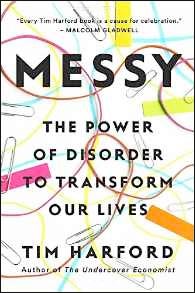 In the corporate environment we are encouraged to be efficient and have our work in order. But what if being a little messy made you a better employee? That’s the idea in the new book Messy: The Power of Disorder to Transform Our Lives, by Tim Harford, a senior columnist at the Financial Times. “There is always a gap between how things look very nice and neat and tidy on the spreadsheet … but seem very different when at ground level,” says Harford, who is also a host of a BBC Radio 4 show called More Or Less. “What may look messy in theory may actually work very well in practice.” Harford offered his unconventional views on the Knowledge at Wharton show on Wharton Business Radio on SiriusXM channel 111
In the corporate environment we are encouraged to be efficient and have our work in order. But what if being a little messy made you a better employee? That’s the idea in the new book Messy: The Power of Disorder to Transform Our Lives, by Tim Harford, a senior columnist at the Financial Times. “There is always a gap between how things look very nice and neat and tidy on the spreadsheet … but seem very different when at ground level,” says Harford, who is also a host of a BBC Radio 4 show called More Or Less. “What may look messy in theory may actually work very well in practice.” Harford offered his unconventional views on the Knowledge at Wharton show on Wharton Business Radio on SiriusXM channel 111
An edited transcript of the conversation follows.
Knowledge at Wharton: Do you get questioning looks from people as to why they would want to have mess in their lives?
Tim Harford: I have found that highly successful people who are at the top of their profession, and are tremendously productive and great professionals, carry a lot of guilt about mess [in their lives]. They’ve told me that my book has made them feel better. So that’s obviously my role in life, to unburden people from their guilt. But [I wonder why] so many successful people don’t draw the conclusion that they are doing fine, and therefore the mess doesn’t matter. Instead they convince themselves that if only they could tidy up they’d be more effective.
Knowledge at Wharton: But because of how busy we are and more and more people are working two jobs to get by, it feels like that there has to be a little bit of mess in our lives.
Harford: Tidying up takes time. If you’re going to decide how messy or how tidy you should be, that’s one of the costs of tidiness. It costs time and energy to get things straight. One may be both literally messy, i.e. emails and papers everywhere, and metaphorically messy like in dealing with complicated people, obstacles or randomness. We tend to underrate how much good that can be doing us. It can be spurring creativity. Or it could just be simply and practically a perfectly functional way to get things done.
“Studies of office environments often find that while things look well organized and neat, you may have a tremendous amount of paperwork all hidden away.”
For people who keep things incredibly tidy, if it works, that’s great. But studies of office environments often find that while things look well organized and neat, you may have a tremendous amount of paperwork all hidden away. You don’t really know where it is. You don’t really know what it is that you should be doing. You’re carrying around a lot of anxiety in the back of your head, but at least your desk looks clean.
Knowledge at Wharton: Where did the idea to write about this come from?
Harford: I was originally interested in the idea of interdisciplinary work, funnily enough. I was asking myself, why is it that we tidy ourselves away into silos? The accounts department won’t talk to the marketing department. The anthropologists won’t talk to the economists and the economists won’t talk to the physicists. The New Yorkers won’t talk to the Angelinos who won’t talk to Princetonians. What is it about all this? That was the starting point.
But then I branched out into different forms of mess. Randomness in David Bowie’s recording studio. Improvisations in the speeches of Martin Luther King, Jr. Messy environments for children. And of course the straightforward mess of having an overflowing inbox or an untidy desk.
Knowledge at Wharton: As you lay out in the book, there are so many elements of what we need to be successful, like creativity, that have some level of disorder around them.
Harford: Yes. One of the great moments for me in writing the book was interviewing the composer and producer Brian Eno, who worked with the late David Bowie, U2 and Coldplay, and many great musicians. He deliberately disrupts musicians in their working environment. When they’re in the recording studio working on their new album, he’ll mess things up. For example, on the random draw of a card, he will tell the best guitarist in the world to play the drums and the best drummer in the world to get off the drums and to play the guitar. He will mess around with people like that. It’s a deliberate strategy.
Eno says two things. One is when you’re being pushed out of your comfort zone like that, you’re paying attention. So we may like things to be very routine and exact, very familiar, and exactly the way we’ve always done them, and that may feel very comfortable. But we get bored and so we get lazy and so we lose our creativity. So when he stresses people out by throwing these messier elements in, he gets their attention and that gets their creativity.
The other thing Eno says is, simply, if you’re forced to try something new, you may finish somewhere new. The unfamiliar simply forces you to find new solutions. That’s true in the recording studio. But it’s true in everyday examples as well.
Knowledge at Wharton: You also say that being messy at times will make you a little more resilient.
Harford: Yes. This is an old idea going back at least to Jane Jacobs, the great scholar of how cities work. [She made that] observation in The Death and Life of Great American Cities, a wonderful, life-changing book published in 1961. She said, “Look, if you’re an urban planner and you’re trying to get things nice and tidy on a map, you will tend to zone things in a straightforward way so the industry goes in one place and the residential stuff goes in another place and the retail goes in a third place. That makes perfect sense from the point of view of the map. But when you’re at street level, that very tidy and well organized system is boring and it’s fragile and it’s not creative. So the streets will be completely deserted at one time of a day and then they’ll be absolutely packed at another time of day because everybody is in the same industry or everyone’s doing the same thing. They won’t learn from each other.
“But when you have this messier, more diverse, more jumbled-together streetscape, old and new buildings, residential and industrial and retail and you mix them all together, you get a lot more evenness in the way the street works. You get people on the street at all times of day, which means it’s always interesting and it always feels safe. It doesn’t make any sense on the map, but it’s a much more, better functioning city.”
It’s worth taking that idea and then thinking about, for example, a government planning a new policy or a chief executive thinking about how to run a business. There is always a gap between how things look very nice and neat and tidy on the spreadsheet, on the PowerPoint presentation, but they’re going to seem very different when you get to ground level. What may look messy in theory may actually work very well in practice.
“What may look messy in theory may actually work very well in practice.”
Knowledge at Wharton: You also bring up Martin Luther King’s “I have a dream” speech. How did that fit into this?
Harford: Some people will be aware that that speech comes in two halves. Remember the context. He’s under tremendous scrutiny. The civil rights legislation is going through Congress. There were debates within the civil rights movement. The TV cameras of the world are focused on him. There were 250,000 people looking at him in the march in Washington, D.C. And he was under time constraints.
The first half of that speech is very carefully scripted. He stayed up all night preparing it. It’s poetic, but it’s not that good. Then halfway through the speech he realizes it’s not that good. He realizes it’s not quite fitting the occasion. It’s not speaking to the people who are actually there. It’s not moving people. He steps away from his script and he takes a biblical flourish and he gets a smattering of applause. People respond to that. Then he doesn’t know where to go after that.
The people behind him on the steps of the Lincoln Memorial know he’s away from script. They’ve got the script; they know he’s not delivering from the script. Behind him the gospel singer Mahalia Jackson who has seen him preach in churches across the country and who’s seen him often talk about this dream that he has just yells out, “Tell them about the dream, Martin.” So he begins to improvise the second half of his speech based on this story that he’d been telling people in the churches, based on this sermon-like style, the preacher style. And he tells them about the dream. Of course that is the half of the speech that we all remember. I discuss it in some depth in the book.
In other speeches of Martin Luther King, he switched from a very carefully prepared speaker who was very competent, very effective, but not brilliant. When he began to improvise, under sheer pressure of time because he couldn’t do anything else, suddenly his speeches broke out of their previous constraints and started to touch people. Of course they contain their imperfections, because any improvised speech will contain imperfections. But it has that vitality and energy.
Maybe when we’re talking to each other, we’re tempted to stick to routines because they feel safe. But sometimes you need to step away from the routine and connect with people in a more honest and maybe a little bit more risky way.
It is the same thing when we’re dealing with companies. Very often we feel like we’re dealing with people who are reading from a script, and if we feel that we’re touching something authentic, although it’s risky, it could be very effective.
Of course Donald Trump is no Martin Luther King, but one of the reasons why he’s an effective campaigner is because he would improvise and people felt that he was speaking in an authentic way, no matter what fact checkers might have said about him and said, “Well, we checked him. This stuff isn’t true.” It felt true because the people who were listening to him felt that he was speaking in an unguarded and improvised way. It’s very powerful whether you’re Donald Trump or whether you’re Reverend Martin Luther King. Improvisation is risky, but a very powerful way to communicate.
“Experimenters said, ‘you can’t have the potted plant or your poster there’ — employees hated the experimenter, they hated the space. They hated the company. They hated everything. Their autonomy had been threatened.”
Knowledge at Wharton: One of the other people you bring up is General Rommel of the German Army in World War II, and that he would just go off of orders on his own tangent in terms of fighting the war. That was one of the things that made him a very tough opponent for various other militaries from around the world.
Harford: [Rommel] was arguably Hitler’s favorite general. The people he kept beating were the British. He was such an amazing and dynamic figure and such an effective general. He believed that war was full of fleeting opportunities. So it was a very messy process. You just had to grab those opportunities. You couldn’t necessarily prepare. You could try, but if you stuck too closely to your plan you would miss all of these opportunities that you had to seize.
The other thing that he believed in was to act quickly. Even if your side wasn’t properly prepared, even if the logistics weren’t quite right, even if your men were tired and you didn’t have enough food, you had to think the other side has got it just as bad.
Again and again, whether on a very small scale with just 10 or 20 infantrymen or with vast tank engagements, Rommel would make a bold move that if you had been on his side, or if you had been with his Army, you would have said, “This is crazy. The people are not prepared. It’s chaos. It’s a total mess.” They were in a mess. But then if you’d gone to the other side — the French or to British — you would have realized it’s a mess on this side too and it’s becoming more of a mess because Rommel is using disorder as a competitive weapon — very effective.
I drew some parallels with Donald Trump and also with Jeff Bezos of Amazon. Bezos was very clear in the early days of Amazon that he’s going to make a strategic move. He seemed to think, “We’re not ready, our warehouses aren’t ready, our systems aren’t ready, but you know what, Barnes & Noble aren’t ready either, and if we move quickly we’ll do okay. If we slow down and get everything nice and tidy and perfect, Barnes & Noble will crush us or Toys ‘R’ Us will crush us or Wal-Mart will crush us.” He was very conscious about that and he’s been proved right.
Knowledge at Wharton: How much of this ends up being an individual philosophy that people will take? And how much of this can be something that a corporation can weave into its operations?
Harford: If a company accepts these messy principles, to some extent that is almost a laissez-faire decision. The company is saying, “Look, we are not going to try to micromanage you. We’re not going to try to organize every minute of your day or tell you how to run your calendar, or tell you how to organize your desk. We’re going to let you, the employee, take control of those decisions.”
One piece of research that changed my views on many things while I was writing the book was done by two psychologists, Craig Knight and S. Alexander Haslam, where they examined the effects of ‘clean desk’ policies. They got people to sit in various office spaces that they’d designed and do tasks like sort some e-mails, do some paperwork, or other regular office tasks. What Knight and Haslam found was, first of all, that people didn’t seem to like a super minimalist office. If it was bare and there were no distractions, people weren’t super comfortable.
A much more powerful finding was that whether the office was full of soft furnishing and potted plants, or whether it was minimalist or not wasn’t the issue. The issue was: did people have control over their spaces. If you’re a neat person, could you make it neat? If you were a messy person, could you make it messy? Or would somebody else come along and change everything for you?
They found that when people had control over their spaces they got loads done. They were happy. Comfortable. Productive. But when the experimenters came in and rearranged the space and said, “Oh, I’m afraid, you can’t have the potted plant there. You can’t put your poster there,” and they would change things, people got very resentful and it was multi-dimensional resentment. They hated the experimenter. They hated the task. They hated the space. They hated the company. They hated everything. It was just because their autonomy had been threatened.
Haslam and Knight have done this work in old people’s homes and in nursing homes as well, and they believe that if you give residents in nursing homes more control over how the nursing home looks, you might get a much messier space because these are very old people. Some of them have dementia. They’re not professional designers. But if they have control over the space, their mental health improves and their happiness improves.
“Improvisation is risky, but a very powerful way to communicate.”
There is a story about Steve Jobs and his interior design ideas at Pixar in the book which I found interesting to discover. It is a famous story about Steve Jobs who was the majority shareholder at Pixar and who had a lot of influence over the Pixar headquarters coming up with this idea that the whole company was going to share a pair of bathrooms. There was going to be one big pair of bathrooms in the middle of the space because that’s serendipity. They’re all going to come together and they’ll all mix together. Of course, serendipity is very important in a creative company. But then it was pointed out to him by a consortium of pregnant women that, “Look, we need to go pretty often. Maybe we need to go two or three times an hour. If we don’t have a bathroom close to us we’ll spend our whole time walking to and from the lobby.”
At first Jobs was very resistant to this. He had this big idea. He didn’t want these pregnant women to spoil it. Steve Jobs has this reputation for being a control freak’s control freak. But he said, “No, okay, you’re right. I’ll find another way to foster serendipity.” The Pixar headquarters now has plenty of bathrooms. It’s an environment where the design is beautiful, but if you go to the offices it’s full of this chaotic riot of different ideas because everybody’s desk is designed like a Disney castle or a Hawaiian paradise or a volcano or something. It’s chaotic, it’s messy, but it’s a very creative space that respects the autonomy of the people who work there, which is the most important thing. It doesn’t matter if it doesn’t look like a magazine issue, what matters is if the people who have to work there every day feel that they’ve got control.
Knowledge at Wharton: How much have you learned from writing this book?
Harford: Writing the book made me realize that there’s a time and a place for everything. Some projects are intrinsically disorganized and create mess as you’re working on them. In other projects you can be tidy. If you’re cooking food it’s going to be messy while you’re doing it, and then it can be tidy when you finish. But that is not so with many work projects, like writing a book. It took me five years to write this book and I was doing other things as well. That’s a bit like cooking a meal that lasts five years. Of course it’s going to be messy most of the time.
There are studies that I discuss in the book of people who keep very tidy desks, whereas people who pile things up — they’re called the “filers” versus the “pilers” — find that the pilers are completely on top of their paperwork and often have much better ratio of knowing where things are. They throw stuff away regularly. They use their archives. The people who create elaborate filing systems very often don’t know where things are. They have huge piles of paperwork they should have thrown away but they haven’t thrown away because they put it into a filing cabinet immediately after they got it. It’s not necessarily a functional way to organize a desk. It looks tidy, but it’s not necessarily for everybody. Not for me.



